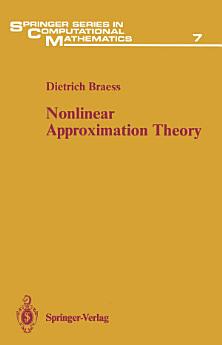Nonlinear Approximation Theory
ડિસે 2012 · Springer Series in Computational Mathematics પુસ્તક 7 · Springer Science & Business Media
ઇ-પુસ્તક
290
પેજ
reportરેટિંગ અને રિવ્યૂ ચકાસેલા નથી વધુ જાણો
આ ઇ-પુસ્તક વિશે
The first investigations of nonlinear approximation problems were made by P.L. Chebyshev in the last century, and the entire theory of uniform approxima tion is strongly connected with his name. By making use of his ideas, the theories of best uniform approximation by rational functions and by polynomials were developed over the years in an almost unified framework. The difference between linear and rational approximation and its implications first became apparent in the 1960's. At roughly the same time other approaches to nonlinear approximation were also developed. The use of new tools, such as nonlinear functional analysis and topological methods, showed that linearization is not sufficient for a complete treatment of nonlinear families. In particular, the application of global analysis and the consideration of flows on the family of approximating functions intro duced ideas which were previously unknown in approximation theory. These were and still are important in many branches of analysis. On the other hand, methods developed for nonlinear approximation prob lems can often be successfully applied to problems which belong to or arise from linear approximation. An important example is the solution of moment problems via rational approximation. Best quadrature formulae or the search for best linear spaces often leads to the consideration of spline functions with free nodes. The most famous problem of this kind, namely best interpolation by poly nomials, is treated in the appendix of this book.
આ ઇ-પુસ્તકને રેટિંગ આપો
તમે શું વિચારો છો અમને જણાવો.
માહિતી વાંચવી
સ્માર્ટફોન અને ટૅબ્લેટ
Android અને iPad/iPhone માટે Google Play Books ઍપ ઇન્સ્ટૉલ કરો. તે તમારા એકાઉન્ટ સાથે ઑટોમૅટિક રીતે સિંક થાય છે અને તમને જ્યાં પણ હો ત્યાં તમને ઑનલાઇન અથવા ઑફલાઇન વાંચવાની મંજૂરી આપે છે.
લૅપટૉપ અને કમ્પ્યુટર
Google Play પર ખરીદેલ ઑડિઓબુકને તમે તમારા કમ્પ્યુટરના વેબ બ્રાઉઝરનો ઉપયોગ કરીને સાંભળી શકો છો.
eReaders અને અન્ય ડિવાઇસ
Kobo ઇ-રીડર જેવા ઇ-ઇંક ડિવાઇસ પર વાંચવા માટે, તમારે ફાઇલને ડાઉનલોડ કરીને તમારા ડિવાઇસ પર ટ્રાન્સફર કરવાની જરૂર પડશે. સપોર્ટેડ ઇ-રીડર પર ફાઇલો ટ્રાન્સ્ફર કરવા માટે સહાયતા કેન્દ્રની વિગતવાર સૂચનાઓ અનુસરો.







